Hayabusa-2’s samples return to Earth
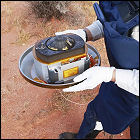 The Japanese space agency, JAXA, successfully recovers the Hayabusa-2 space probe’s sample return container after its return to Earth in Austrailia. The container’s precious cargo is 100 milligrams of surface and subsurface material retrieved by Hayabusa-2 from the surface of asteroid 162173 Ryugu during a series of touch-and-go maneuvers performed between February and July of 2019. Though it drops its samples off during a close flyby of Earth, Hayabusa-2 remains in space, where JAXA hopes to redirect it to study further asteroids, though the probe will no longer have the ability to gather or return samples.
The Japanese space agency, JAXA, successfully recovers the Hayabusa-2 space probe’s sample return container after its return to Earth in Austrailia. The container’s precious cargo is 100 milligrams of surface and subsurface material retrieved by Hayabusa-2 from the surface of asteroid 162173 Ryugu during a series of touch-and-go maneuvers performed between February and July of 2019. Though it drops its samples off during a close flyby of Earth, Hayabusa-2 remains in space, where JAXA hopes to redirect it to study further asteroids, though the probe will no longer have the ability to gather or return samples.
Hayabusa-2 now departing Ryugu
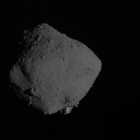 Japan’s Hayabusa-2 uncrewed spacecraft, carrying samples of material from asteroid 162173 Ryugu, begins its long trip home after spending nearly a year and a half in Ryugu’s orbit, where it deposited autonomous robotic landers and fired a projectile into Ryugu’s surface to loosen material for capture and return to Earth. First launched in 2014, Hayabusa-2’s return trajectory to Earth is expected to bring the samples of asteroid material home to a safe landing in Australia in late 2020.
Japan’s Hayabusa-2 uncrewed spacecraft, carrying samples of material from asteroid 162173 Ryugu, begins its long trip home after spending nearly a year and a half in Ryugu’s orbit, where it deposited autonomous robotic landers and fired a projectile into Ryugu’s surface to loosen material for capture and return to Earth. First launched in 2014, Hayabusa-2’s return trajectory to Earth is expected to bring the samples of asteroid material home to a safe landing in Australia in late 2020.
Hayabusa 2: back to the asteroid belt
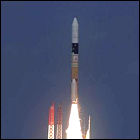 The Japanese Aerospace Exploration Agency (JAXA) launches the Hayabusa-2 unmanned space probe, intended to study and sample asteroid 162173 Ryugu in 2018. Mission plans call for the ion-engine-powered Hayabusa-2 to remain at Ryugu for a year before returning to Earth with its sample. Hayabusa-2 also carries a European-built lander and an explosive penetrator to expose the asteroid’s subsurface material (using the same principle as the Deep Impact mission to Comet Tempel 1 in 2005.
The Japanese Aerospace Exploration Agency (JAXA) launches the Hayabusa-2 unmanned space probe, intended to study and sample asteroid 162173 Ryugu in 2018. Mission plans call for the ion-engine-powered Hayabusa-2 to remain at Ryugu for a year before returning to Earth with its sample. Hayabusa-2 also carries a European-built lander and an explosive penetrator to expose the asteroid’s subsurface material (using the same principle as the Deep Impact mission to Comet Tempel 1 in 2005.
Hayabusa comes home
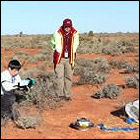 Japan’s Hayabusa unmanned space probe releases a re-entry capsule containing samples of surface material it gathered from asteroid 25143 Itokawa in 2005. The capsule survives a punishing 25G re-entry and is recovered from the Australian outback, as planned, while Hayabusa itself burns up in Earth’s atmosphere. The sample payload – approximately 1500 grains averaging 10 micrometers in diameter – reveals that Itokawa has a composition virtually identical to a chondrite meteorite. A significant achievement in the history of the Japanese space program, the Hayabusa mission inspires no fewer than three movies, and a sequel of its own: the Hayabusa-2 space probe, approved in August 2010 and scheduled for launch in 2014.
Japan’s Hayabusa unmanned space probe releases a re-entry capsule containing samples of surface material it gathered from asteroid 25143 Itokawa in 2005. The capsule survives a punishing 25G re-entry and is recovered from the Australian outback, as planned, while Hayabusa itself burns up in Earth’s atmosphere. The sample payload – approximately 1500 grains averaging 10 micrometers in diameter – reveals that Itokawa has a composition virtually identical to a chondrite meteorite. A significant achievement in the history of the Japanese space program, the Hayabusa mission inspires no fewer than three movies, and a sequel of its own: the Hayabusa-2 space probe, approved in August 2010 and scheduled for launch in 2014.
Homeward, Hayabusa!
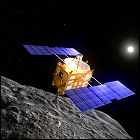 JAXA’s unmanned Hayabusa spacecraft fires its ion engines to depart asteroid 25143 Itokawa, embarking on a five-year trek back to Earth to return surface samples it obtained of the asteroid. Hayabusa has experienced numerous technical glitches, and continues to experience further problems, including a total loss of contact with Earth for several weeks. Only two out of the vehicle’s four ion engines are still functional, and its battery system is only partially reliable, but it is carrying its precious cargo of the first sample material from an asteroid back to Earth.
JAXA’s unmanned Hayabusa spacecraft fires its ion engines to depart asteroid 25143 Itokawa, embarking on a five-year trek back to Earth to return surface samples it obtained of the asteroid. Hayabusa has experienced numerous technical glitches, and continues to experience further problems, including a total loss of contact with Earth for several weeks. Only two out of the vehicle’s four ion engines are still functional, and its battery system is only partially reliable, but it is carrying its precious cargo of the first sample material from an asteroid back to Earth.
Hayabusa on Itokawa
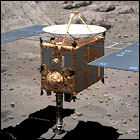 A second attempt is made by the Japanese Aerospace Exploration Agency to bring its unmanned space probe, Hayabusa, close enough to gather a sample of surface material from asteroid 25143 Itokawa. It attempts to deploy a mini-rover called Minerva to explore Itokawa from the surface, but a glitch results in a trajectory that leaves Minerva tumbling into space, never to reach Itokawa. Hayabusa lands on Itokawa’s surface itself, though mission controllers don’t realize this for several more days. Contact is lost with Hayabusa for a short while, and when it is regained, the vehicle has left the surface and gone into safe mode.
A second attempt is made by the Japanese Aerospace Exploration Agency to bring its unmanned space probe, Hayabusa, close enough to gather a sample of surface material from asteroid 25143 Itokawa. It attempts to deploy a mini-rover called Minerva to explore Itokawa from the surface, but a glitch results in a trajectory that leaves Minerva tumbling into space, never to reach Itokawa. Hayabusa lands on Itokawa’s surface itself, though mission controllers don’t realize this for several more days. Contact is lost with Hayabusa for a short while, and when it is regained, the vehicle has left the surface and gone into safe mode.
Hayabusa pulls up
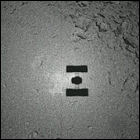 The first attempt to maneuver the unmanned space probe Hayabusa close enough to scoop up a sample of material from the surface of asteroid 25143 Itokawa is aborted by ground controllers at the Japanese space agency, JAXA. The spacecraft’s navigational system finds it difficult to maintain a precise lock on the elongated asteroid, so its automatic safety systems abort the approach to preserve Hayabusa intact. Another attempt to bring Hayabusa close enough to gather material from Itokawa’s surface will be made a week later.
The first attempt to maneuver the unmanned space probe Hayabusa close enough to scoop up a sample of material from the surface of asteroid 25143 Itokawa is aborted by ground controllers at the Japanese space agency, JAXA. The spacecraft’s navigational system finds it difficult to maintain a precise lock on the elongated asteroid, so its automatic safety systems abort the approach to preserve Hayabusa intact. Another attempt to bring Hayabusa close enough to gather material from Itokawa’s surface will be made a week later.
Hayabusa at Itokawa
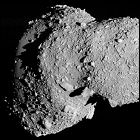 The Japanese unmanned space probe Hayabusa arrives at its destination, asteroid 25143 Itokawa, from which it will gather a sample of material for return to Earth and attempt to deploy a mini-rover. Hayabusa settles into an orbit around the sun parallel to Itokawa, rather than orbiting the asteroid itself, and maintains an initial distance of roughly 12 miles.
The Japanese unmanned space probe Hayabusa arrives at its destination, asteroid 25143 Itokawa, from which it will gather a sample of material for return to Earth and attempt to deploy a mini-rover. Hayabusa settles into an orbit around the sun parallel to Itokawa, rather than orbiting the asteroid itself, and maintains an initial distance of roughly 12 miles.
Hayabusa!
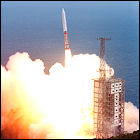 Japan’s Institute of Space and Astronautical Science (ISAS), launches the unmanned Hayabusa space probe on a mission to gather material from asteroid 25143 Itokawa. Intended to reach Itokawa in two years, and then return the asteroid samples to Earth in 2010, Hayabusa will also attempt to drop a small rover on Itokawa’s surface and will test an ion engine propulsion system. The name “Hayabusa” – translating to “peregrine falcon” – is only bestowed upon the spacecraft once it reaches space; prior to that, Hayabusa is known by its engineering designation, MUSES-C. A few months after Hayabusa’s launch, ISAS itself is renamed JAXA (the Japanese Aerospace Exploration Agency).
Japan’s Institute of Space and Astronautical Science (ISAS), launches the unmanned Hayabusa space probe on a mission to gather material from asteroid 25143 Itokawa. Intended to reach Itokawa in two years, and then return the asteroid samples to Earth in 2010, Hayabusa will also attempt to drop a small rover on Itokawa’s surface and will test an ion engine propulsion system. The name “Hayabusa” – translating to “peregrine falcon” – is only bestowed upon the spacecraft once it reaches space; prior to that, Hayabusa is known by its engineering designation, MUSES-C. A few months after Hayabusa’s launch, ISAS itself is renamed JAXA (the Japanese Aerospace Exploration Agency).